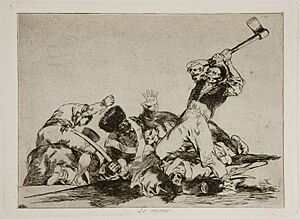The Madhouse facts for kids
Quick facts for kids The Madhouse |
|
|---|---|
| Spanish: Casa de locos | |
| Artist | Francisco Goya |
| Year | 1812–1819 |
| Medium | Oil on panel |
| Dimensions | 46 cm × 73 cm (18 in × 29 in) |
| Location | Real Academia de Bellas Artes de San Fernando, Madrid |
The Madhouse (also called Casa de locos in Spanish) is a famous painting by Francisco Goya. He painted it between 1812 and 1819. This artwork shows a scene Goya saw at a place for people with mental health challenges in Zaragoza, Spain. It shows different people inside, each dealing with their own struggles. Goya created this painting after a tough time in his own life. He had been very sick and faced difficulties with his family.
What the Painting Shows
This painting has a very closed-in feeling. The only light comes from a small, barred window high up on the wall. This makes the people below seem trapped. The people in the painting are unique characters. They are shown doing strange or sad things. For example, one person wears a headdress made of feathers. Another is fighting while wearing a three-cornered hat. Someone else is making a blessing gesture. Many of the people are not wearing clothes.
Some of these figures might also represent powerful people in society, like priests or soldiers. Goya often explored ideas about a "world turned upside down" in his art. This painting is similar to his series of prints called Los disparates.
Goya's Inspiration
During Goya's time, places for people with mental health issues were a popular topic. People were interested in how these places worked. Sometimes, patients were even chained up. People often thought that those with mental illnesses were "possessed." They were sometimes even put on display for public entertainment.
Goya knew about mental health challenges firsthand. Some of his family members had suffered from them. He also faced serious illness himself. In 1792, he became very sick. He had trouble walking and balancing. He also lost some of his sight and became completely deaf. Even though he got better, he remained deaf for the rest of his life.
This difficult time in Goya's life changed his art. His paintings became darker and more serious. He said that these experiences allowed him to create art that showed his imagination and ideas, not just what people asked him to paint.
Other Works by Goya
Goya had painted about mental health issues before. In 1794, he created Yard with Lunatics. This painting shows patients outside in an asylum yard. Some figures are wrestling, while a guard tries to control them. Goya made this painting around the time he was getting better from his own illness. Yard with Lunatics was special because it showed people with mental health challenges in a more realistic way. It was different from the usual, unfair pictures of the time.
The Madhouse is different from Yard with Lunatics. In The Madhouse, the people are inside a dark room. They are shown as suffering, not just as people who need to be held back. Goya also created a series of eighty-three prints called The Disasters of War. He made these between 1810 and 1820. These prints were published after he died. They show the terrible things that happened during the wars in Spain when Napoleon's army was there. In these works, Goya wanted viewers to focus on the shocking and disturbing parts of war. He didn't try to make them beautiful. Goya is known for showing violence and suffering in his art. He was brave enough to create art that made people think and feel deeply.
See also
 In Spanish: Casa de locos para niños
In Spanish: Casa de locos para niños
- List of works by Francisco Goya


